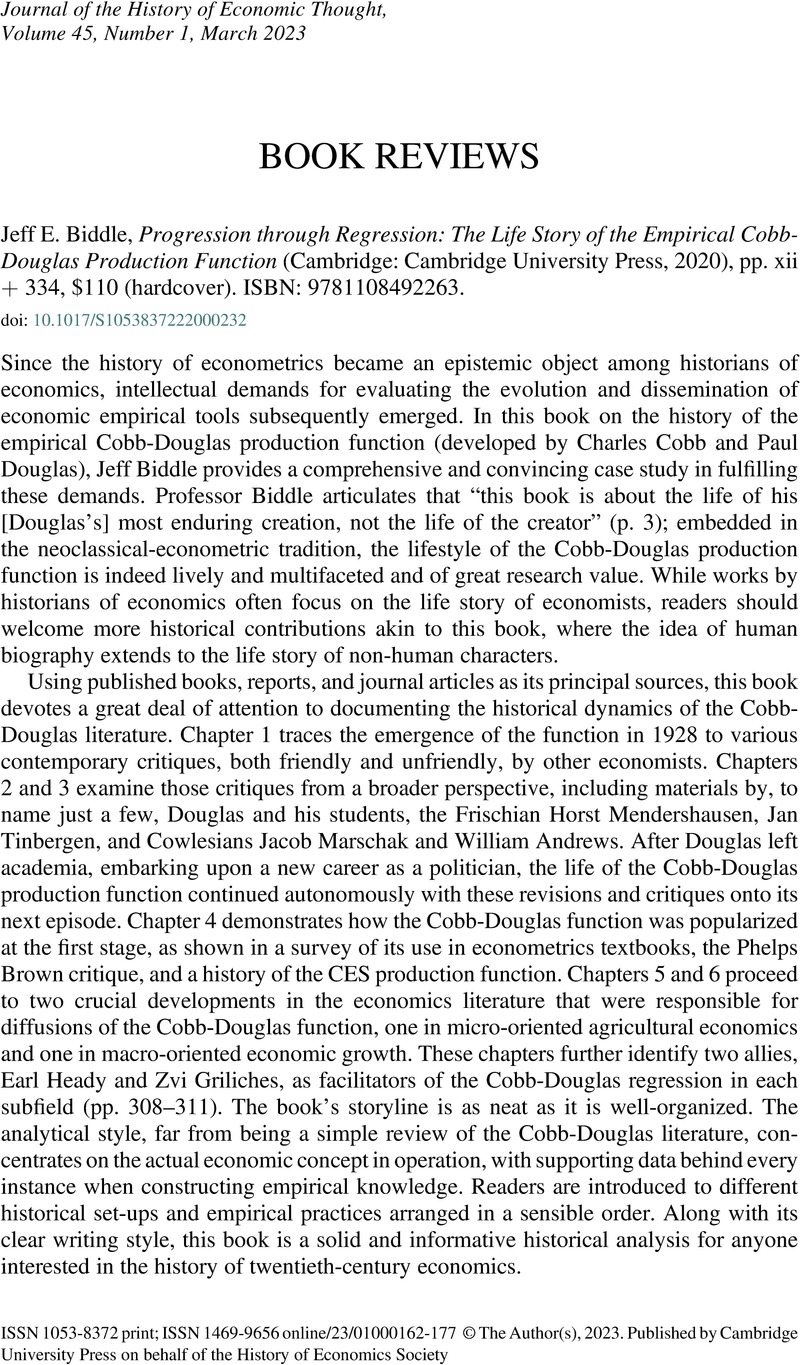No CrossRef data available.
Article contents
Jeff E. Biddle, Progression through Regression: The Life Story of the Empirical Cobb-Douglas Production Function (Cambridge: Cambridge University Press, 2020), pp. xii + 334, $110 (hardcover). ISBN: 9781108492263.
Review products
Jeff E. Biddle, Progression through Regression: The Life Story of the Empirical Cobb-Douglas Production Function (Cambridge: Cambridge University Press, 2020), pp. xii + 334, $110 (hardcover). ISBN: 9781108492263.
Published online by Cambridge University Press: 01 February 2023
Abstract
An abstract is not available for this content so a preview has been provided. Please use the Get access link above for information on how to access this content.

- Type
- Book Review
- Information
- Copyright
- © The Author(s), 2023. Published by Cambridge University Press on behalf of the History of Economics Society
References
REFERENCES
Allen, Roy G. D., and Bowley, Arthur L.. 1935. Family Expenditure: A Study of Its Variation. London: P. S. King & Son.Google Scholar
Becker, Gary S. 1976. “Prefatory Note.” Journal of Political Economy 84 (4): S1.CrossRefGoogle Scholar
Biddle, Jeff E. 1996. “H. Gregg Lewis.” In Samuels, Warren, ed., American Economists of the Late 20th Century. Cheltenham: Edward Elgar, pp. 174–193.Google Scholar
Biddle, Jeff E., and Hamermesh, Daniel S.. 2017. “Theory and Measurement: Emergence, Consolidation, and Erosion of a Consensus.” In Backhouse, R. E. and Cherrier, B., eds., The Age of the Applied Economist: The Transformation of Economics since the 1970s. History of Political Economy 49 (suppl.). Durham, NC: Duke University Press, pp. 34–57.Google Scholar
Chao, Hsiang-Ke. 2019. “Inference to the Best Model of the Consumption Function.” History of Political Economy 51 (3): 493–513.CrossRefGoogle Scholar
Cheng, Chung-Tang. 2021. “The Microeconometrics of Household Behaviour: Building the Foundations, 1920–1960.” PhD thesis, London School of Economics and Political Science.Google Scholar
Hicks, John R., and Roy, G. D. Allen. 1934a. “A Reconsideration of the Theory of Value. Part I.” Economica 1 (1): 52–76.CrossRefGoogle Scholar
Hicks, John R., and Roy, G. D. Allen. 1934b. “A Reconsideration of the Theory of Value. Part II. A Mathematical Theory of Individual Demand Functions.” Economica 1 (2): 196–219.CrossRefGoogle Scholar
Morgan, Mary S. 1990. The History of Econometric Ideas. Cambridge, UK: Cambridge University Press.CrossRefGoogle Scholar
Thomas, Jim J. 1989. “The Early Econometric History of the Consumption Function.” Oxford Economic Papers 41 (1): 131–149.CrossRefGoogle Scholar
Thomas, Jim J. 1992. “Income Distribution and the Estimation of the Consumption Function: A Historical Analysis of the Early Arguments.” History of Political Economy 24 (1): 153–181.CrossRefGoogle Scholar


